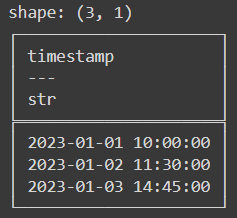
|
|
Handling timestamp columns efficiently is crucial for many data science and engineering tasks. Timestamp columns often require specific operations like parsing, formatting, and time-based filtering. In this article, we will explore three good code examples of how to call and manipulate timestamp columns using different methods and libraries. Calling a Column Name when it is a Timestamp in PythonAccessing timestamp columns can be done through various methods in Python using libraries such as Pandas and Polars. Let us see a few different examples using these approaches for a better understanding of the concept. Using PandasPandas is a popular data manipulation library that provides robust support for timestamp data. Here, we’ll demonstrate how to call and manipulate a timestamp column using pandas. In this example, we first create a pandas DataFrame with a timestamp column. We then convert the ‘timestamp’ column to datetime using pd.to_datetime(). Finally, we access the timestamp column by calling df[‘timestamp’]. Output: 0 2023-01-01 10:00:00 Using SelectIn this example, we will use the Python Polars module. The df.select(“timestamp”) selects only the “timestamp” column from the DataFrame df. This method explicitly specifies the column name within the select method, which is convenient when you want to fetch specific columns by name. Output:  Calling Colum with Timestamp using Polars select() Using Polars with Time-Based FilteringIn this example, we first create a Polars DataFrame with a “timestamp” column containing string representations of datetime values. It then converts the “timestamp” column to datetime format using str.strptime() function with the specified format. Finally, it accesses and prints the converted “timestamp” column. Output: shape: (3,) ConclusionHandling timestamp columns is a common requirement in data processing and analysis. Python libraries like pandas and Polars provide powerful tools to manipulate and access timestamp data efficiently. In this article, we demonstrated three good code examples of how to call and work with timestamp columns in Python using pandas and Polars. These examples covered basic access, conversion to datetime, and time-based filtering, providing a solid foundation for working with timestamp data in your projects. |
Reffered: https://www.geeksforgeeks.org
| Python |
Type: | Geek |
Category: | Coding |
Sub Category: | Tutorial |
Uploaded by: | Admin |
Views: | 19 |